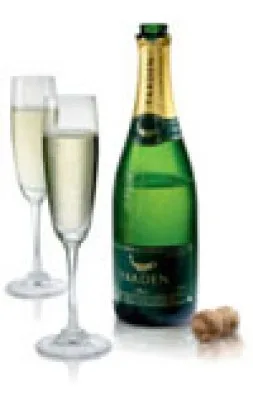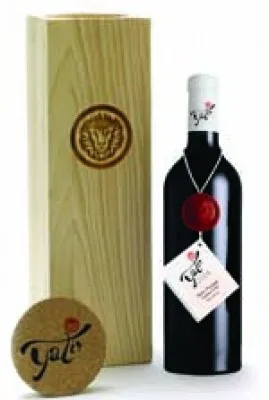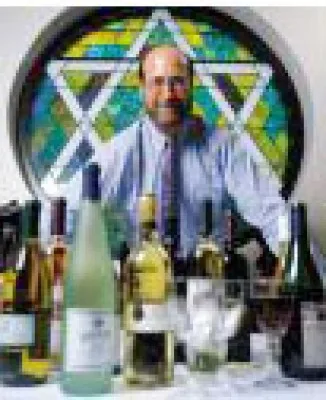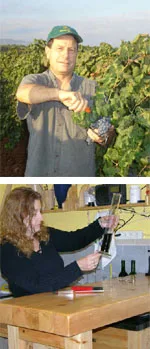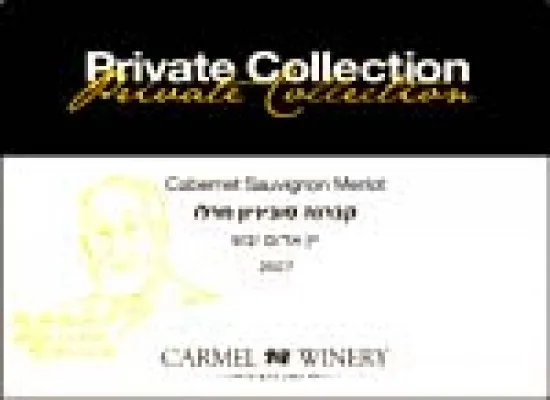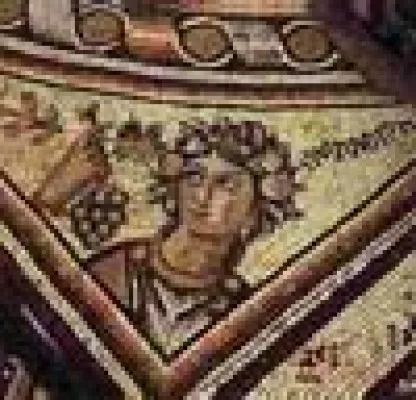The Golan Heights Winery has led the way on the Israeli wine scene for 25 years. In that time they have had three managing directors: Shimshon Welner, Segev Yerovam & Shalom Blayer; Six chief winemakers: Philip Steinschriber, Mike Lake, Kenneth Greene, Andrew Star, Jim Klein & Victor Schoenfeld and two winemaking consultants: Peter Stern & Zelma Long. Each and every one of them has played a part in an extraordinary success story.
For their first 15 years, the Golan Heights Winery was unarguably the outstanding winery in Israel with the best kept vineyards, the most technologically advanced winery and the finest viticulturists & winemakers in Israel. Most of the international prizes won by Israeli wines were produced by the Golan Heights Winery.
However, in the last few years a number of new circumstances have arisen to challenge their supremacy.
1. Other wineries have advanced. Wineries such as Castel & Margalit are well established and have many followers; larger wineries such as Carmel and Barkan have improved quality no end and new wineries such as Flam, Yatir & many others, are now making international class wines. Many more wineries are sharing in the international prizes awarded to Israeli wineries. In short, the gap is closing and the competition is greater.
2. The Golan Heights Winery continues to introduce new varieties and new wines as though this was a competition in itself. It is rare for a similar sized winery to deal with so many wines, so many different wine styles and so many different grape varieties. One would think this could affect quality & focus.
3. Finally, the elitist days of the Golan are over. They have grown to become a very big winery harvesting 7,000 tonnes of grapes in 2004, (on the Golan Heights & in the Upper Galilee combined). They now have had to enter the murky world of the mass market, discounting & advertising which previously they had the luxury of never doing. Again there is a danger that sales become more important than quality witness the last years of Mondavi as an independent winery.
However, though these are definite threats, Golan Heights is still number one. If a collector wanted to buy a wine to last 10-15 years, he would still be well advised to choose a Yarden, or even in some cases, a Gamla wine, above almost every other Israeli winery. The winery is still innovating & dragging the rest of the industry in its wake and though no longer alone, it is still winning the majority of medals awarded to Israel.
Managing Director
There have been three Managing Directors. Each has made his mark in the development of the winery and maintained the winery’s position as the pioneers of the Israel wine industry. Shimshon Welner was the entrepreneur who created the winery like a hi-tec start up, bruising the complacent wineries, and particularly Carmel. Israel was really in the dark ages as far as wine was concerned. Segev Yerovam turned the winery into the elite in terms of wine quality, wine marketing, presentation & PR activities. In everything, Golan shone far ahead of its competitors. Shalom Blayer harnessed the growth into a large winery managing to compete in the mass market whilst maintaining the quality. Under all three, the Golan Heights Winery has remained the best and the most innovative winery in the country.
Shimshon Welner (1983 1988) was the one to shake up the wine establishment by creating the Golan Heights Winery.
He was astute enough to go to California to import expertise, rather than relying on the existing knowledge in Israel. He appointed Peter Stern, who was involved in all the winemaking and some of the marketing decisions from the beginning.
Winemakers appointed were all UC Davis graduates. The first time internationally trained winemakers were employed by a winery.
The very successful oil lamp logo, with colored mosaic tile inside, was chosen at this time as was the brand name Yarden. It has never had to be changed or adapted, being both immediately successful & long lasting.
The winery introduced Merlot, Chardonnay & White/ Johannisberg Riesling to Israel.
Welner was presented with the first major international award for an Israeli wine: In 1987 winning a gold medal & the Winiarski Trophy for the Yarden Cabernet Sauvignon 1984 at the International Wine & Spirit Competition in London . This really put Israel on the international wine map. The next year’s Yarden Cabernet Sauvignon 1985 won no fewer than three major international prizes.
He was also responsible for marketing Yarden wines in what was then a very innovative way. He priced the wines much higher than consumers were used to and initially supplied only to exclusive venues such as the Hilton Tel Aviv and King David Hotel in Jerusalem. A large percentage of production was exported to America & England. This approach added value to the product & raised the profile of the wines.
He closed a deal with Shaked Brothers to be distributors in Israel an inspired decision as they also played a big part in the winery’s development.
During this time Americans, in particular, began to refer to Yarden and Gamla as Israel’s first world class wines.
Segev Yerovam (1988 1998) transformed the winery from a one man band into a medium sized operation solely dedicated to quality and perception of quality. The winery was managed with the efficiency of a military campaign but with the atmosphere of a family. Pursuit of quality was the objective.
Yerovam built the visitors center to be outstandingly the best in the country with tours both informative & interesting.
He started the country’s first wine school a little before its time. It did not last, but the winery took responsibility for advancing wine culture in Israel.
Yerovam organized a series of stylish, memorable functions such as the night harvest visits for customers & journalists, who were flown up to the Golan; the symposium for which the star guest was Robert Mondavi and finally he dreamed up and organized the first culinary & gourmet festival Golan Vintage,which was attended by famous chefs & wine personalities. The standard of winery PR events today, owes much to the high standards set then by the Golan Heights Winery.
During his time, the Golan Heights Winery became the first winery in the world to win the Grand Prix d’Honneur at Vinexpo three years in a row. This was achieved with Yarden Cabernet Sauvignon 1985, Yarden Merlot 1988 and Yarden Cabernet Sauvignon 1989 awarded in 1989, 1991 & 1993 respectively.
Sales were mainly to restaurants, hotels, wine stores & only a little to supermarkets.
Weather stations were put in the vineyards feeding up to date information to the winery. Viticulturally, the Golan Heights Winery was far ahead from its competitors. The first winery to give importance to the vineyard, that today is taken for granted.
The winery grew installing the very best technology available. An exaggerated number of smaller sized tanks gave the winemaker the ability to separate varieties, vineyards and even different parts of the same vineyard. The attention to detail and total control from the vineyard to bottle was a lesson to all other wineries in Israel.
Grape varieties like Pinot Noir, Cabernet Franc, Sangiovese, Gewurztraminer & Muscat Canelli were planted for the first time.
Yerovam created Yarden Katzrin Israel’s first super de luxe wine, produced only in special years. The first vintage was 1990.
He initiated the program for Israel’s first bottle fermented sparkling wine. In Golan style, the assistant winemaker was sent to work & learn in the champagne region & returned to produce a high quality product strictly produced by the champagne method. In 1996 the Yarden Blanc de Blancs won the Trophy at the IWSC in London.
Shalom Blayer (1998 until 8/2008) developed the winery still further. Under Blayer’s stewardship, the Golan Heights Winery became a large winery.
Yarden Mount Hermon Red became the country’s number one selling brand, without any advertising.
Blayer founded a wholly owned subsidiary in New York, Yarden Inc., to import and market Golan’s wines and soon became the most successful Israeli winery in America.
He cancelled agreements with the Israeli distributors and opened his own distribution system in Israel. For the first time the winery was in total control of its distribution and sold to every market sector including supermarkets.
He also developed the winery’s interests in the Upper Galilee by opening Galil Mountain Winery, which the Golan Heights Winery own 75% in a joint venture with Kibbutz Yiron.
His marketing team were responsible for the powerful black and white advertising campaign referring to the Golan Heights Winery as the land of wine, which was very impressive.
During his tenure, Yarden was first invited by the Wine Spectator to participate in the New York Wine Experience in 1999 open to literally the finest wineries in the world. The winery has been invited back on each subsequent occasion.
The first quality Syrah & Pinot Noir were launched in Israel under the Yarden label.
HeightsWine made from grapes frozen at the winery, in imitation of ice wine, was produced and became an instant gold medal winner.
The launch of their first single vineyard wines, an organically grown Chardonnay, a nouveau style wine made with Gamay using carbonic maceration, and a dessert wine made from grapes treatedwith botrytis at the winery, were all innovations in the last 2 years!
Golan Heights Winery sells wines under three labels. The premier label is Yarden. The second label, Gamla represents the best value in relation to quality and the Golan label is mainly for supermarkets. Yarden Katzrin is arguably Israel’s finest de luxe & most expensive wine. Yarden Mount Hermon Red is still Israel’s largest selling brand.
The many wines produced by the winery fall into four categories:
a. Genuine world class wines
b. International standard wines, like Gamla Cabernet Sauvignon
c. Wines which are neither of the above, but are still pioneering wines in Israel because they have introduced a new variety or wine style, for example Yarden Gewurztraminer or Gamla Sangiovese.
d. Others which make up the portfolio from the Sauvignon Blancs to the Golan wines.
The genuine world class wines are under the Yarden label. These wines continue to win medals, trophies and prizes that any world class winery would be extremely proud of. The main winners, year after year, are:
Yarden Blanc de Blancs – Sparkling Wine
Yarden Katzrin Chardonnay
Yarden Chardonnay
Yarden Cabernet Sauvignon
Yarden Merlot
Yarden HeightsWine – Dessert Wine.
Add these to Yarden Katzrin, a Cabernet Sauvignon, Merlot & Cabernet Franc blend produced only in 1990, 1993, 1996 and 2000, and the new single vineyard Yarden El Rom Cabernet Sauvignon and Yarden Ortal Merlot and they have a formidable range.
Credit must go to current winemaker, Victor Schoenfeld probably Israel’s outstanding winemaker, for maintaining the standards, and for continuing to innovate. The number of wines produced & the size of winery do not affect his ability to produce so many different award winning wines. How many wineries in the world can claim to produce sparkling, white, red and dessert wines with such a record of proven success.
The new managing director from September 2008 is Anat Levi Rushansky.


